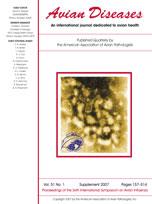In Asia, domestic ducks have been shown to play a pivotal role in H5 high-pathogenicity avian influenza virus transmission. We have also observed that the same situation may exist for H5 low-pathogenicity avian influenza (LPAI) virus. No data are available regarding the protection afforded by commercial inactivated vaccines against H5 LPAI virus infection in ducks, and two preliminary experiments using commercial inactivated vaccines gave poor results. Virus-like particles (VLPs) have been shown to be immunogenic in different species. With regard to the influenza model, the matrix (M) protein has been shown to be necessary for the formation of VLPs. In order to attempt to develop a VLP influenza vaccine expressing hemagglutinin and neuraminidase (NA) of interest, we generated a triple recombinant baculovirus (rB) expressing three structural proteins: H5, N3, and M, derived from a recent French LPAI virus strain. Although the three proteins were successfully expressed in rB-infected cells and displayed the expected biological activity, no VLPs were observed. Despite this result, the protection afforded to ducks by rB-infected cell lysates was assessed and was compared with the protection afforded by an inactivated commercial H5N9 vaccine. For this purpose, specific-pathogen-free Muscovy ducks (15 per group) received rB-infected cell lysates (3 wk apart), while a second group received the H5N9 vaccine. Ten days after the boost, a homologous virus challenge was implemented. Both vaccines induced positive hemagglutination inhibition titers and M immune response, whereas lysates of rB-infected cells elicited NA immune response. Tracheal and cloacal sheddings were measured using M-based real-time-reverse transcription–polymerase chain reaction and were compared with the sheddings of vaccinated and unvaccinated infected controls. Lysates of rB-infected cells afforded a significant decrease of cloacal shedding and a delayed peak of tracheal shedding, whereas the inactivated commercial vaccine afforded a significant decrease of tracheal shedding only.
How to translate text using browser tools
1 March 2007
Assessment of the Protection Afforded by Triple Baculovirus Recombinant Coexpressing H5, N3, M1 Proteins Against a Homologous H5N3 Low-Pathogenicity Avian Influenza Virus Challenge in Muscovy Ducks
Anne Prel,
Ghislaine Le Gall-Reculé,
Martine Cherbonnel,
Béatrice Grasland,
Michel Amelot,
Véronique Jestin
ACCESS THE FULL ARTICLE

Avian Diseases
Vol. 51 • No. s1
March 2007
Vol. 51 • No. s1
March 2007




